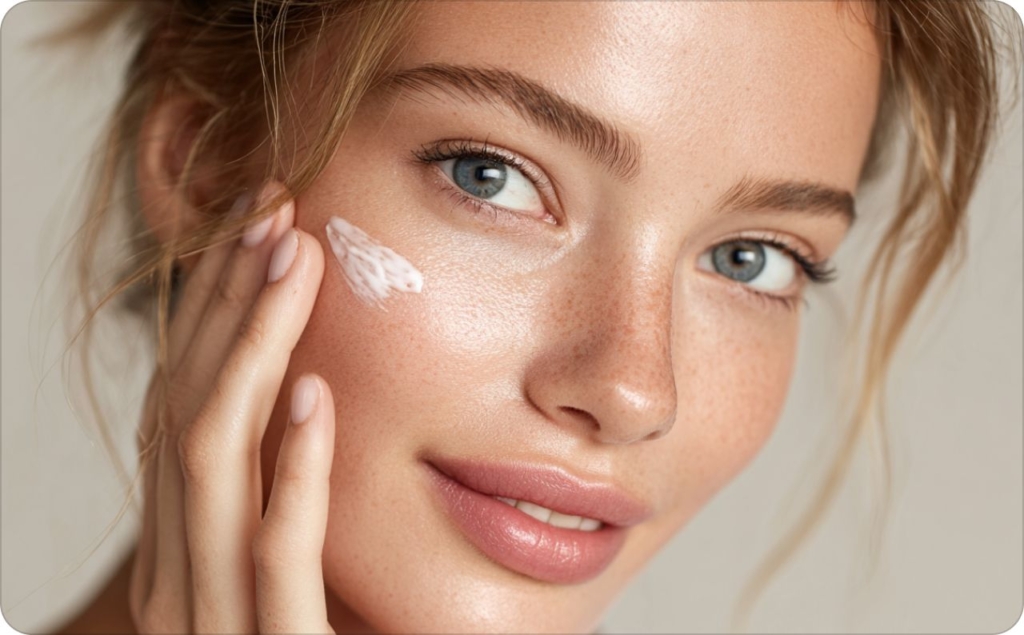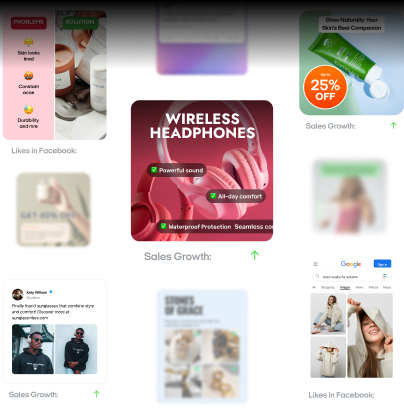12 types of display ads: Your ultimate digital marketing handbook
How well do you really know your ad formats? Explore 12 types of display ads every marketer must master to build a winning digital strategy.
Choosing the wrong display ads can drain your budget. But picking the right ones can skyrocket your brand visibility and ROI.
In 2023, global spending on display ads hit $207.4 billion, making them the largest digital ad format worldwide. By 2026, experts predict that number to jump to $266.6 billion, showing just how competitive this channel can be.
Display ads let you reach people where they browse, watch, and read online. They also run on the Google Display Network and programmatic platforms, using real-time bidding to put your message in front of high-intent users.
Banner ads are ideal for fast brand awareness. Video ads spark higher engagement and can dramatically lift click-through rates.
Native placements blend into content feeds, so viewers see them as part of the experience. Rich media or interactive ads get prospects to actively engage with your creative.
No fancy equipment or big design team? No problem. Modern ad platforms offer easy templates and automation so you can launch in minutes.
Next, we’ll break down exactly what display ads are, how they work, and why they’re a must-have in your digital strategy. If you searched “types of display ads explained,” you’re in the right place — let’s dive in!

What are display ads?
If your ads aren’t performing, it might not be your product — it could be your format. Display ads often fill the gap when campaigns aren’t scaling.
A display ad is a visual, digital ad that shows up on websites, mobile apps, or social platforms. You’ve likely seen banners on news sites, video carousels in recipe apps, or animated promos inside mobile games.
These ads rely on programmatic technology, like the Google Display Network or DSPs, to automate when and where they appear. Unlike text-based or search ads, display ads focus on visuals and interactive elements to engage users.
Every display ad includes a creative asset and a clear CTA. It also uses targeting data to find the right audience at the right moment.
Early display ads were static banners, but modern formats are mobile-optimized, interactive, and adaptable in real time. They’re built for brand awareness or direct conversions, depending on your campaign goals.
You can track performance through ad impressions, click-through rate, and conversion data. These insights show what’s working — and where you can refine for better ROI.
In a world driven by attention and data, display ads merge creative storytelling with digital strategy. They give you the power to reach people where they spend their time — online. Now, let’s see how interactive formats push engagement even further.
Types of display ads: Your definitive guide to digital marketing formats
If your AI display ads aren’t converting, the culprit might be the ad format itself. You have options — banners, native, video, interactive, or shoppable — and each type accomplishes different marketing goals. In this guide, you’ll learn how these formats power brand awareness, direct response campaigns, and everything in between.
Why formats matter
The type of display ad you choose influences cost, engagement, and your ability to capture leads or drive sales. Banner ads, for instance, are easy to produce but often struggle with “banner blindness”.
Meanwhile, native ads blend with editorial content and feel less intrusive, which can boost trust and clicks. Understanding each format’s strengths, from video storytelling to interactive engagement, helps you optimize for ROI.
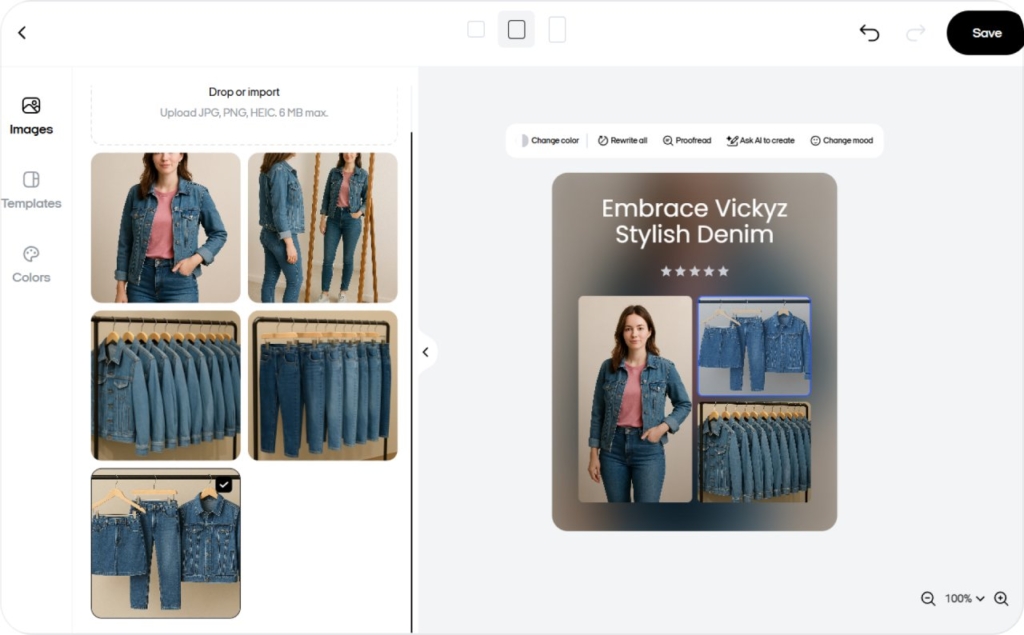
Comparing popular ad types
You’ll find banner, native, video, interactive, responsive and expandable, interstitial and pop-up, plus shoppable and rich media ads. Each one addresses specific objectives, such as brand recall, direct purchases, or data collection.
Banner ads are common and cost-effective, typically sold on a CPM basis. Native ads blend so seamlessly with publisher content that they generate up to 53% more views than traditional banners.
Video ads leverage sight, sound, and motion for higher retention — viewers remember about 95% of a video’s core message.
Interactive ads encourage users to tap, swipe, or play, offering a gamified experience that can lead to triple the engagement rates of static formats.
Responsive ads adapt their size and design across devices, while expandable ads reveal more content once clicked or hovered. Interstitial and pop-up ads demand attention by covering the screen at key moments, though they risk annoying users if shown too often.
Finally, shoppable or rich media ads merge commerce with creativity, letting shoppers buy directly within the ad.
Quick comparison of popular display ad types
| Ad type | Cost range | Engagement rate | Best use case | Device compatibility | Ease of production |
| Banner ads | Low to moderate | Lower CTR on average | High-impression campaigns that drive ad impressions and brand recall | Desktop, mobile, tablets | Easy |
| Native ads | Moderate | Higher than banners | Content-centric strategies that blend seamlessly with editorial context | All platforms | Moderate |
| Video ads | Moderate to high | Up to 95% message recall | Storytelling, product demos, and deeper emotional engagement | Desktop, mobile, social | Complex |
| Interactive ads | Moderate to high | 2-3x higher than static formats | Quizzes, polls, gamified experiences to collect zero-party data | Web, mobile apps | Complex |
| Responsive & expandable | Low to moderate | Varies by viewability | Mobile-first campaigns, programmatic buys requiring cross-device reach | Desktop, mobile, tablets | Easy to moderate |
| Interstitial & pop-up | Low to Moderate | High | Urgent promotions, lead captures, or direct-response triggers | Web, mobile apps | Easy to moderate |
| Shoppable & rich media | Moderate to High | Up to 267% more engagement | eCommerce, seamless in-ad checkouts, visual product discovery | Web, mobile, social | More complex |
Banner and native ads: A closer look
Banner ads remain the workhorse of display campaigns. They’re fast to produce and easy to scale across display networks. They’re perfect if you want top-of-funnel visibility and straightforward creative.
However, users often skim right past them unless your visuals truly stand out. Native ads, on the other hand, match the look and feel of the surrounding website or platform.
They’re labeled “sponsored” or “promoted,” but their design feels more organic, which can significantly improve click-through rates.
If you want a broader reach with minimal customization, you’ll lean on banner ads. If your goals involve deeper engagement and trust-building, native ads often deliver stronger results.
Video ads that drive emotional connection
Video ads tell your story with motion and audio, making them ideal for brand-building or product demos. They can run on platforms like YouTube, social feeds, or streaming services.
While they usually cost more to produce, the pay-off can be huge: up to 95% message retention compared to just 10% with text.
Short, punchy UGC video ads for e-commerce can keep viewers from skipping too early. Tracking metrics like completion rate helps you understand how much of your story resonates, and you can adapt future creative accordingly.
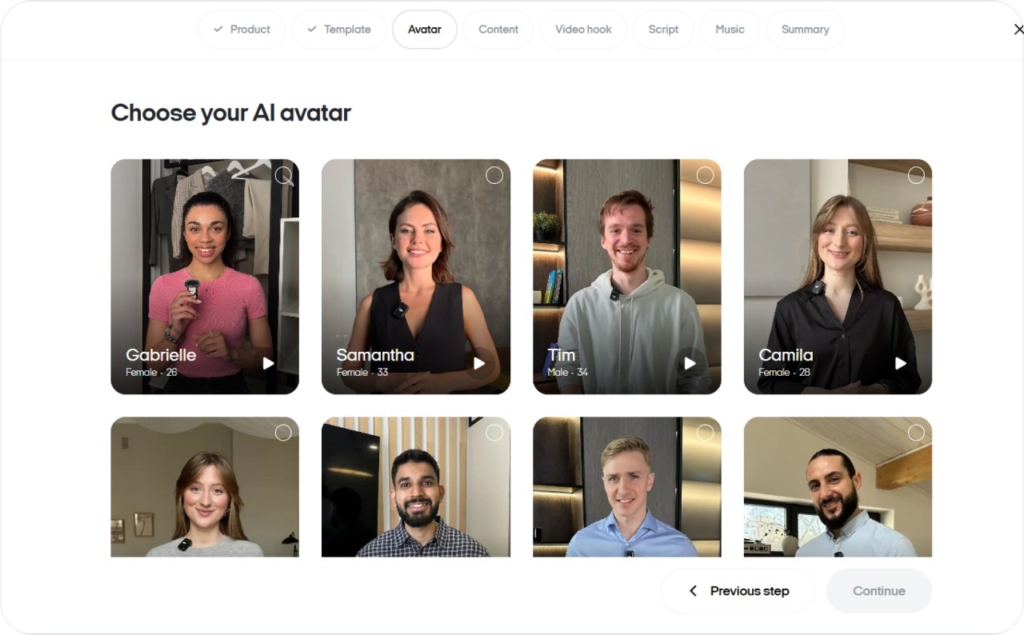
Interactive ads and zero-party data
Interactive ads invite direct participation, like polls, quizzes, or swipeable galleries. This gamified approach can yield a 300% lift in engagement while also gathering zero-party data.
A skincare brand, for example, created a “Find Your Routine” quiz inside an expandable ad unit and boosted its conversions by 2.5x.
You’ll need a bit more development time, but interactive ads often deliver richer insights and a more memorable user experience. According to Forbes, 81% of marketers believe interactive content is far more attention-grabbing than static.
Responsive and expandable ads for mobile-first campaigns
Responsive ads fit multiple placements automatically. They adjust imagery, text, and layout to match each device, reducing your creative workload.
Expandable ads extend their size on click or hover, revealing deeper content or interactive elements. Both formats excel in mobile-first strategies, especially if you’re running a programmatic campaign that targets audiences across desktops, smartphones, and tablets.
Preview your ads on different screens before launch to ensure consistent design and clear calls to action.
Interstitial and pop-up ads for immediate impact
Interstitial ads show up full-screen at natural pauses, like moving between app sections. Pop-up ads layer over a page, grabbing attention fast.
These formats are great for immediate conversions if you’re pushing a time-sensitive deal or collecting email subscribers. The downside is their potential to irritate users if they’re overused.
Browsers may also block them, so watch your metrics to ensure you’re seeing genuine engagement rather than quick bounces.
Shoppable and Rich media ads for seamless purchases
Shoppable ads allow in-ad transactions, reducing steps in the customer journey. Rich media ads combine multiple elements, like video, animations, or interactive hotspots, to boost engagement.
These formats work wonders for eCommerce, merging visual flair with direct buying options. If your goal is higher average order value or driving sales without requiring extra clicks, shoppable and rich media ads are worth the investment. They do take extra development effort, but the reward is often immediate conversions.
Choosing the right format for your goals
Every ad format has a sweet spot. If you need broad reach with simple creatives, stick to banners or basic responsive ads. When you want users to linger and explore, interactive and video ads drive engagement.
If you’re looking to build trust without interrupting the user experience, native ads can outperform standard banners. You can also use pop-ups or interstitials for urgent promotions, as long as you’re mindful of user fatigue.
And if eCommerce revenue is your priority, rich media and shoppable ads help buyers complete purchases on the spot.
Final thoughts
Your display ad format isn’t just about aesthetics — it impacts your click-through rates, conversions, and overall user experience. By matching the right format to your objectives, budget, and audience, you’ll see stronger results.
Don’t forget to test variations, monitor performance metrics like CTR, ROI, and completion rates, then refine your approach. The right ad type — whether it’s a well-placed banner, a captivating video, or a frictionless shoppable ad — can transform fleeting impressions into meaningful interactions.
Why use display ads?
If your ad spend isn’t driving real results, it might be time to rethink your format. Display ads offer a powerful mix of visual storytelling, precise targeting, and measurable ROI — all at a flexible cost.
Drive brand awareness and engagement
Unlike search ads that meet existing intent, display ads create it. They help you reach users early in the funnel with dynamic visuals that build brand awareness and spark curiosity before your audience even knows what they’re looking for.
Use banner ads to stay top of mind. Go with native or video ads to deliver product stories in a more engaging format.
Retarget and convert warm leads
Display isn’t just for awareness — it’s for conversion too. If someone visits your site and leaves, retargeting ads can bring them back.
Just ask Magoosh. According to HubSpot, their online test prep company made $58,608 in revenue from just $11,000 in ad spend, achieving a 486% ROI by showing tailored retargeting ads to past visitors.
Control your budget and scale efficiently
You don’t need a big budget to start. With models like CPC and CPM, you only pay for real engagement or reach.
Start with $500/month to test your targeting and creatives. Then scale what works based on conversion metrics and performance optimization data.
Measure, refine, repeat
Track CTR, impressions, and conversion rate in real time. A healthy CTR for display ads typically ranges from 0.35% to 0.9%, depending on your targeting and creative.
Use A/B testing to experiment with different visuals, headlines, or CTAs. Small tweaks — like a headline change — can lift performance and reduce cost per conversion.
The bottom line
Well-placed display ads keep your brand visible, adaptable, and competitive. With the right mix of funnel strategy, creative assets, and budget control, you can turn wasted impressions into real business outcomes.
Overview of display ad pricing models
You want to invest in display ads without wasting money. Choosing the right pricing model is the key.
Cost per click
You pay only when someone clicks, usually $0.50 to $5 per click. This model suits lead generation and direct conversions, because you pay for action, not just exposure.
If your click-through rate drops, test fresh visuals or new headlines. Keep an eye on cost per acquisition to see if each click turns into real revenue.
Cost per mille
You pay per 1,000 impressions, often $2 to $15. It’s perfect for brand awareness and product launches, because you reach a wide audience fast.
If nobody engages, you could be paying for empty views. Try a stronger message or bolder design to spark real interest.
Fixed pricing
You pay a flat fee — anywhere from $250 to $5K per month — for a slot on a specific site. It’s ideal for niche sponsorships or blogs with a relevant audience.
Ask for data on monthly views or user demographics. If their traffic isn’t a good fit, you risk paying for an uninterested crowd.
Choosing your model
If you have a tight budget, CPC can tie spend to real clicks. If you need reach, CPM casts the widest net.
A niche site? Fixed pricing gives predictable exposure. No matter your choice, track key metrics like CPA or engagement to confirm your ads are delivering tangible results.
Optimize for ROI
Compare your cost per acquisition against the revenue you earn. Adjust your model, message, or creative if you’re not hitting profitable outcomes.
Below is a rewritten version of the revised content, aligned with a Sprout Social editorial style. It uses you-focused language, maintains clear subheadings, and reduces bullet points to improve readability and flow. The narrative remains conversational yet authoritative, and each section provides actionable insights.
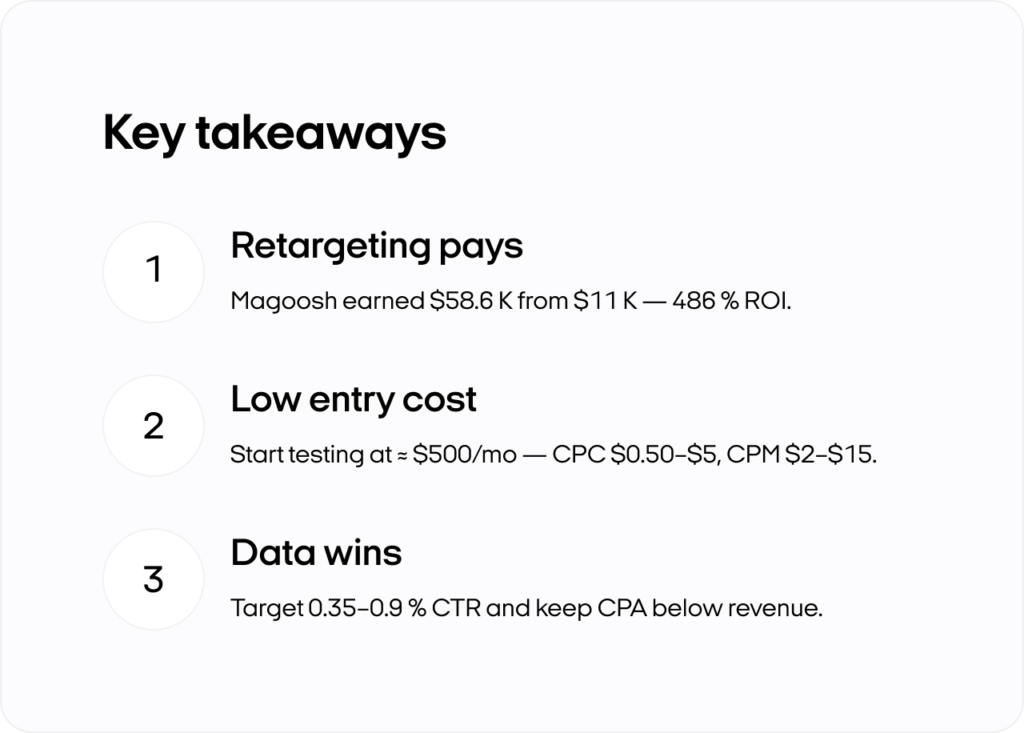
Best practices for designing effective display ads
You want high-performing display ads that convert. This guide shows you how to design, test, and optimize your display creatives without wasting time or budget.
Keep one clear message
Your value proposition should be front and center. Focus on a single headline, one image, and a bold CTA that shows why people should click.
For example, switching “Learn More” to “See Pricing” can boost CTR by double digits. Strong CTA strategies let users know exactly what they’ll get.
Prioritize mobile ad tips
Most users see ads on mobile, so put responsive design first. Keep file sizes under 150KB for fast loads and use large, easy-to-tap buttons.
Emarketer says short attention spans demand instant relevance. Failing to engage quickly means wasted impressions.
Guide the eye with hierarchy
Place your headline at the top, visuals in the middle, and your CTA at the bottom. White space keeps everything clean and helps your offer pop.
Cut any element that doesn’t lead users closer to the call-to-action. Clear, fast comprehension is the heart of display ad design.
Run structured A/B tests
Wondering how to run ad creative testing? Change only one element, like headline text or button color, so you know what caused the difference.
Let each variant run at least 1,000 impressions or a full week for statistical significance. A 20–30% performance lift means you’ve found a winner.
Optimize based on performance
If your CTR drops, test a sharper headline or fresh visuals. If conversion rates dip, refine your value proposition or match imagery to your landing page.
Watch for creative fatigue — when impressions stay high but clicks stall, it’s time to rotate new ads. Improving CTR is an ongoing process, not a one-time fix.
Refresh creatives and iterate
Even small tweaks can revive engagement. Change colors, update your CTA, or swap out imagery to see if performance jumps.
Let data guide you. Keep iterating until you see tangible gains in conversion rates and ROI.
Measure what matters
Responsive design and focused messaging form the core of effective display ad campaigns. Next, we’ll discuss display ad performance tracking so you can connect each design tweak to CTR, engagement, and final conversions.
Conclusion and next steps
If your display ads aren’t delivering, you now have a plan to fix them. You learned how to align formats to goals, design for mobile, run effective A/B tests, and measure real results.
You discovered how to match ad formats to campaign objectives and track crucial metrics like CTR and conversion rate. Keep these pillars in mind as you refine your display ad strategy over time.
Use Google Ads Experiments or Meta Ads Manager to swap headlines or CTAs one element at a time. Set up a Google Data Studio dashboard for weekly reviews of CTR, bounce rate, and conversions.
Digital advertising never stands still. Test, measure, and optimize — then repeat for consistent, data-driven ROI.
Also recommended


